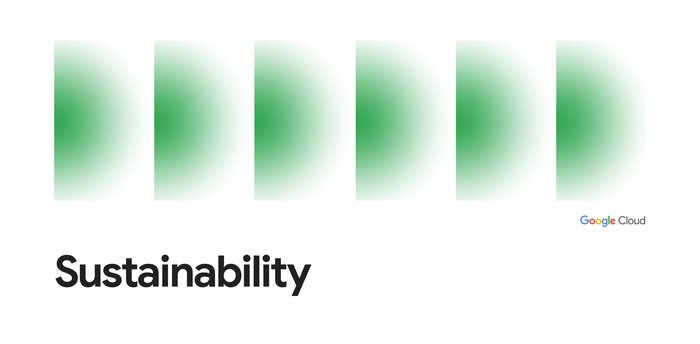Timely progress towards around-the-clock carbon-free energy
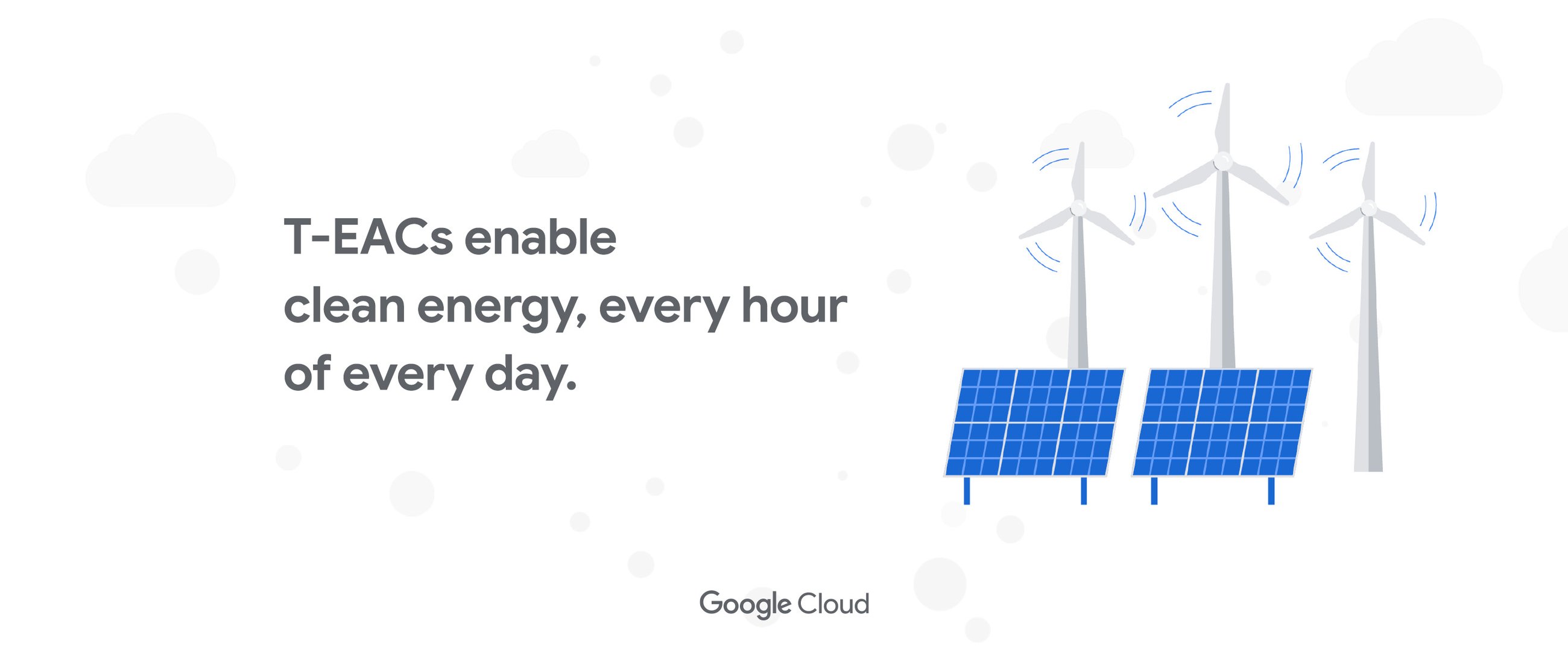
Maud Texier
Head of Energy Development, Google
When we set out to achieve 24/7 carbon-free energy across our global operations by 2030, we knew that we would need better tools to track energy consumption and production. After all, you can’t manage what you don’t measure, and existing approaches to clean energy tracking were not designed to track hour-by-hour energy use.
As Google and others move toward ‘round-the-clock carbon-free energy, we need new systems that enable energy consumers, system operators, and governments to know exactly what kinds of energy are being produced, consumed, and traded on an hourly basis across every electricity grid. That’s why we announced last year that we were piloting a new tool to advance this more granular approach to energy tracking: Time-based Energy Attribute Certificates (T-EACs).
Once fully developed and widely deployed, T-EACs will not only help Google achieve our 24/7 carbon-free goal, but will also generate valuable new insights about the availability of carbon-free energy on electricity grids during every hour of every day. This information will help energy consumers better understand their energy use, while empowering governments and system operators to develop more rapid and cost-effective strategies for decarbonization. Perhaps most excitingly, it will also create price signals that stimulate new investments into technologies and projects that deliver carbon-free energy at the times when it’s most needed, accelerating decarbonization across entire electricity grids.
Inspired by this vision, we’ve spent the past year engaging partners around the world to advance the development and adoption of T-EACs. Today we are pleased to report significant progress across a number of dimensions, including expanding the use of hourly certificates within and outside of Google, accelerating the development of tools and systems to unlock energy data and hourly matching, and creating technical standards to drive the widespread adoption of T-EACs.
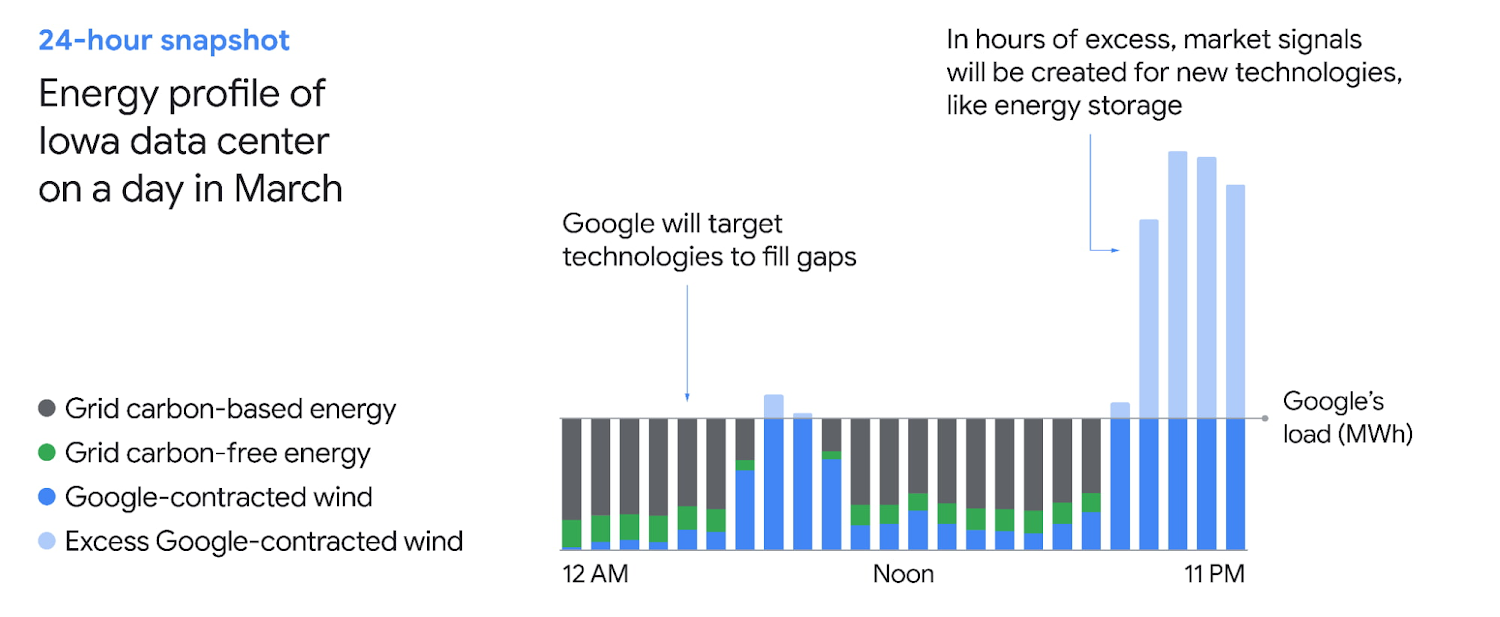

Momentum amongst clean-energy registries
Some of the most important stakeholders in advancing T-EACs are the registries that create, track, and manage the energy attribute certifications (EACs) associated with clean-energy generation. Historically, these registries have not issued or tracked certificates on an hour-by-hour basis, but that is beginning to change as demand grows for 24/7 carbon-free energy. We have been working with registries around the world to accelerate this shift, and to create new products and services for tracking energy attributes on a more granular basis.
In the United States, for example, we partnered with M-RETS, a non-profit that tracks and validates energy attribute certificates, to expand the hourly transaction capabilities of their platform and enable the tracking and retirement of hourly certificates by all of its users. We’ve also been working with APX, a leader in market-based environmental technologies, to support the retirement of hourly Renewable Energy Certificates (RECs) within the Southwest Power Pool (SPP) through the APX North American Renewables Registry platform. As a result of this work, electricity generators across the Central and Midwest United States will soon have the option to retire certificates on an hourly basis wherever hourly data is available.
Similarly, we’ve collaborated with the Danish grid operator, Energinet, as they build the technical foundation to support granular certification and develop innovative applications such as the Project Energy Origin platform. Building on their early successes, Energinet is now engaging with industry partners to advance these solutions beyond Denmark, in collaboration with other Transmission System Operators across Europe.
Finally, in Latin America we launched a pilot led by The International REC Standard Foundation (I-REC Standard), in close collaboration with Evident Services and our suppliers, ACCIONA Energia and AES Andes. Taking advantage of granular electricity data available in Chile, we were able to match our Chilean data center’s hourly energy consumption with hourly generation from the three renewable energy projects that meet 100% of its annual power demand, and to retire hourly certificates for every REC issued in 2021.
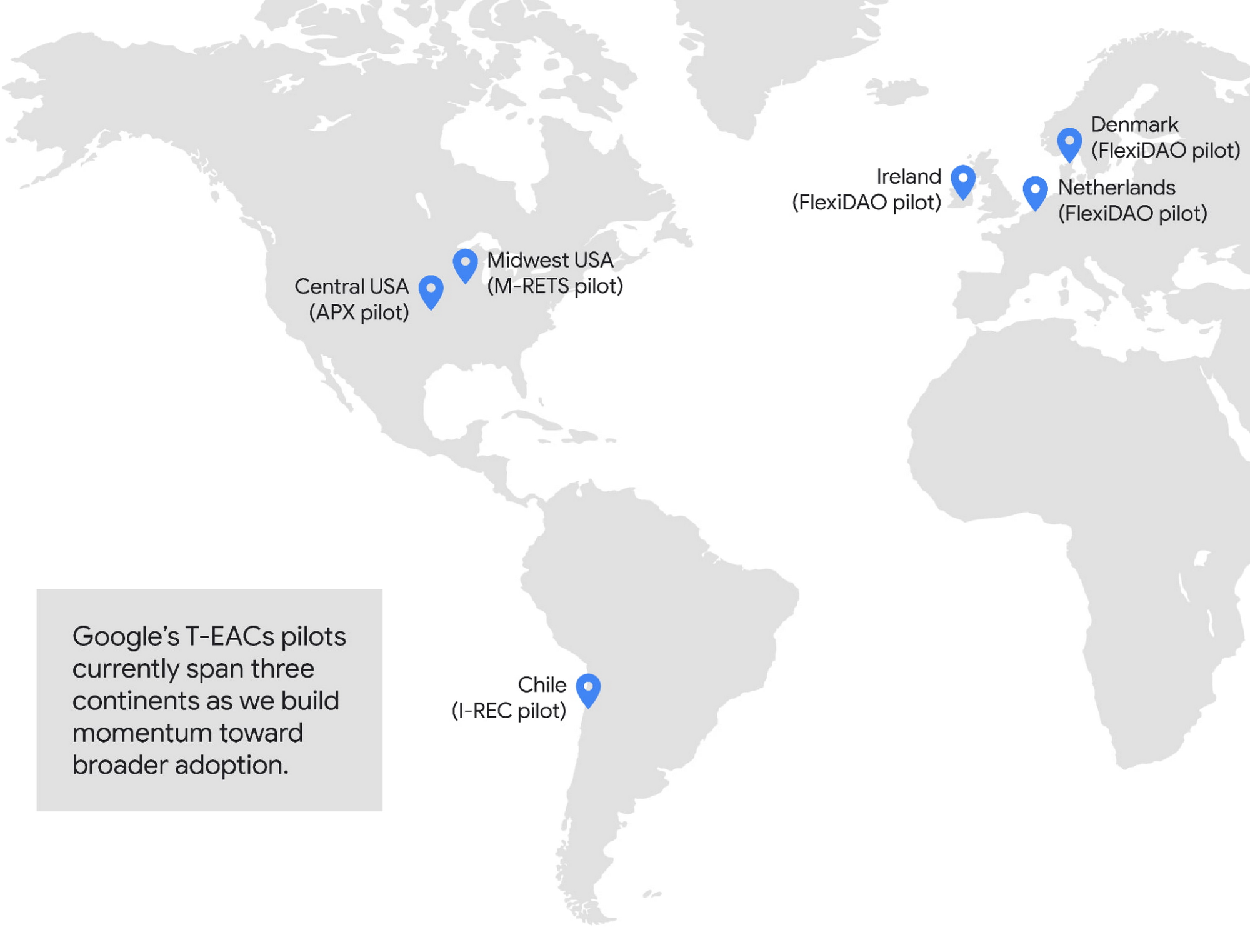

We have also seen exciting progress outside of Google, including growing interest in T-EACs amongst public-sector energy users and pilot projects in new regions. For example, The Netherlands Embassy in Bangkok recently announced an hourly clean-energy certificates pilot with The Electricity Generating Authority of Thailand (EGAT), with the goal of building out Thailand’s clean-energy trading infrastructure to support its national carbon neutrality goal.
In addition to creating infrastructure for hourly energy tracking, the many T-EACs pilot projects currently underway are generating valuable lessons that will support the broader adoption of granular energy certificates. Our work in Chile, for example, taught us that hourly tracking creates new contractual considerations for clean energy projects under joint ownership, which need to be accounted for in order to avoid double counting of hourly certificates by registries and project developers.
Data and software for hourly energy matching
While registries will play a critical role in the adoption of T-EACs at scale, T-EACs will only achieve their full potential if energy consumers have better tools and systems to access and organize their energy data and to match their energy consumption with hourly clean-energy purchases.
To help address this need, we initiated a project with the software provider FlexiDAO to simplify access to and aggregation of energy data throughout our portfolio in Denmark, Ireland, and the Netherlands. This project is helping us streamline our 24/7 carbon-free energy matching process across these countries, and to validate our matching through the retirement of hourly certificates from our clean energy projects in Denmark and the Netherlands. It’s also helped us identify key operational challenges related to data access, which point to a need for more centralized data hubs and standardized authorization processes.
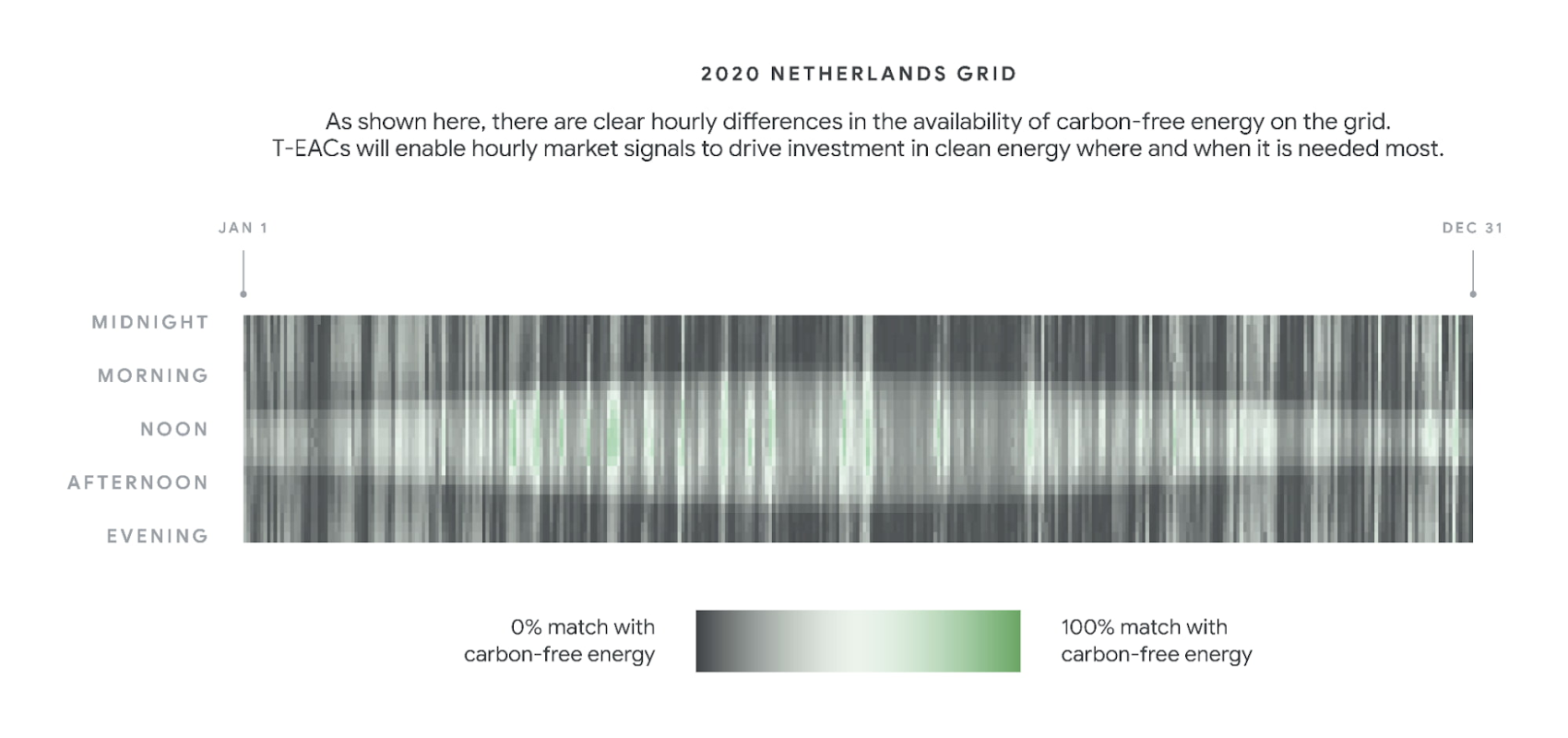

It’s not just Google that has been supporting the development of new tools to unlock granular energy data and hourly clean energy matching: over the last year we’ve seen exciting collaborations between energy suppliers and consumers in the Netherlands and the UK to launch hourly clean-energy matching pilots.
Importantly, governments are also starting to view hourly energy data as a tool for accelerating the use of promising new energy technologies to support their decarbonization goals: the European Union, for example, is considering how granular energy tracking, with new data and software solutions, could support the roll-out of green hydrogen by verifying that the power used to produce hydrogen comes from clean energy sources. Additionally, this month the US Department of Defense and General Services Administration released a first-of-its-kind joint request for information that asks prospective energy suppliers to detail their methodologies for tracking and reporting carbon-free energy on an hour-by-hour basis.Standardization of hourly tracking
As hourly tracking initiatives multiply and grow, there is a danger that numerous sets of tools, definitions, and technical specifications will proliferate simultaneously, resulting in a fragmented ecosystem and a lack of interoperability. Standardization will therefore be critical in driving the widespread adoption of hourly certificates, by enabling the development of robust markets and infrastructure that operate efficiently on a global scale.
That’s why Google.org provided a grant to the industry-led EnergyTag initiative, which has made significant progress in organizing the market for hourly certificates and bringing together key stakeholders to collaboratively develop industry standards. As a founding member of EnergyTag’s Advisory Board, we were pleased to contribute to its preliminary whitepaper, and we are looking forward to the imminent release of EnergyTag’s official guidelines, a major milestone in the establishment of granular certificates as a recognized, robust and tradable instrument.
We’re also excited to join the Linux Foundation’s LF Energy project, a global open-source initiative focused on decarbonizing energy systems. As a Strategic Member of LF Energy, Google is playing an active role in the Carbon Data Specification Consortium, which is creating standards that will bring greater consistency to hourly energy data and make it more accessible to consumers. In addition to enabling more informed decision making by energy consumers, this will support the widespread adoption of T-EACs.
What’s next for hourly certificates
Looking ahead, we’re most excited about the market transformation and grid-level decarbonization that hourly matching will unlock. In addition to helping consumers verify where their energy comes from each hour, digitally tagging every unit of energy with both time and location data will generate critical information about the hourly availability of carbon-free energy across electricity grids. Coupled with growing efforts to update carbon accounting frameworks to better account for the grid-level emissions impact of clean-energy projects, this will drive the widespread reallocation of capital towards the highest-impact clean energy projects while giving policy makers new tools to incentivize energy consumers to buy clean power around the clock.
We are excited to see what the future holds for hourly certificates, and hopeful that these instruments will accelerate the adoption of 24/7 carbon-free energy and the decarbonization of electricity grids worldwide. In the meantime, we’ll continue to work with our partners to scale hourly certificates across our own portfolio, to ensure we meet our goal of running our global operations on 24/7 carbon-free energy by 2030.


